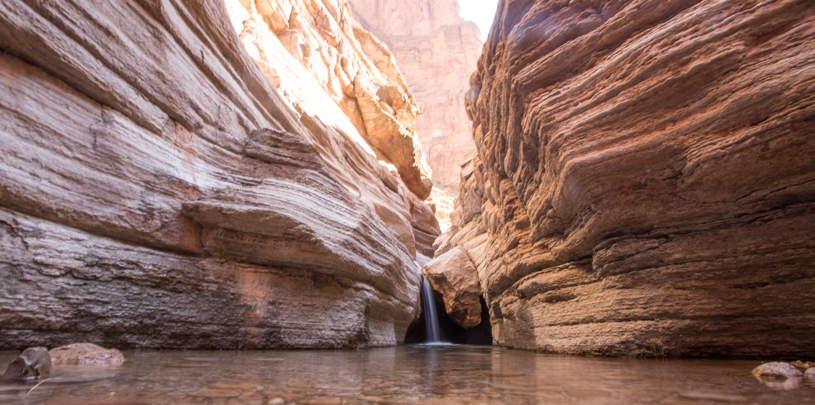
 by Roger Clark, Grand Canyon Director
by Roger Clark, Grand Canyon Director
The gateway town of Tusayan pumps water from wells 3,000 feet deep in order to supply hotels and retail shops at the doorstep of Grand Canyon National Park’s busiest entrance. These giant straws suck groundwater from the same source that feeds many of the Grand Canyon’s precious seeps and springs. This water is the lifeblood of the canyon, vital to plants, animals, and people, including members of the Havasupai Tribe, who live at the bottom of the canyon.
With more than 6 million visitors per year, the waterlines, parking lots, and infrastructure on the Grand Canyon’s south rim are bursting at the seams. Nonetheless, a developer has enlisted the town of Tusayan in claiming that the solution includes building thousands of new hotel rooms, an RV park, conference center, resort, and possibly a dude ranch to boot — over 1.8 million square feet of commercial space. Their plan also includes residential development that would suck even more water from deep underground, not to mention the light pollution, traffic, and other stresses this massive growth would bring.
After failing to push a similar project through in 2016, Stilo Development Group is back, teaming up with Tusayan in a campaign to develop 350 acres of private land — two parcels isolated inside the Kaibab National Forest near Grand Canyon National Park. To get to these islands of private land, they need roads and utilities, which means they need easements across national forest land.
View in full screen (suggested for mobile)
The last time the Forest Service turned the developer down, it concluded that the proposal wasn’t in the public interest, emphasizing that the planned mega-resort “is deeply controversial, is opposed by local and national communities, would stress local and Park infrastructure, and have untold impacts to the surrounding Tribal and National Park lands.” Three years later, that’s still true. Although the new proposal has scaled back what the mega-resort would include, a developer’s profits are still not worth gambling the long-term loss of life-giving seeps and springs that flow from beneath the Grand Canyon’s south rim.
For over 100 years, Grand Canyon’s south rim developments have confirmed that water can flow uphill to money. In 1901, a spur line from the Santa Fe Railroad began carrying two commodities that enabled businesses to flourish beyond what early settlers dreamed possible. Coaches loaded with tourists and tanker cars filled with water delivered the means to build booming enterprises on the waterless edge of the canyon, where the nearest source flows from springs located several thousand feet below the rim.
Today, the national park pumps water uphill from a spring located a dozen miles across the canyon. And just outside of the park’s entrance gate, Tusayan reported pumping 57 million gallons from its wells in 2014, and that use is increasing. Remember, groundwater that the town draws directly from the deep aquifer is the same water that feeds seeps and springs below the canyon’s south rim. Now the developer wants to increase that pumping to pave the way for more growth.
The National Park Service has been documenting long-term declines in the flows of springs beneath the canyon’s south rim. The effects of drought, climate change, and accelerating pumping of groundwater are taking a toll on the Grand Canyon’s deep regional aquifer.
Back in 2014, the park service estimated that Tusayan’s groundwater pumping could increase four-fold by 2024 if plans for the Stilo development were to move ahead.

Just as pollution from the nearby Canyon uranium mine risks contaminating the Grand Canyon’s seeps and springs, Tusayan’s use of the same regional aquifer threatens to pump it dry. That’s why the Havasupai Tribe filed a lawsuit in 2016 against the owners of Tusayan’s wells claiming that Tusayan pumping more and more groundwater will cause irreparable harm to the tribe by threatening its sole source of water.
Stilo and the town recently submitted a scaled-back proposal to the Forest Service again asking for easements to access its two private parcels, which are surrounded by national forest land. If approved, the developer would build roads and utility lines across 52 acres of the Kaibab National Forest outside Grand Canyon National Park. The easements would pave the way for the developer to add 2,500 hotel rooms and another 194 acres of residential construction. And, most worryingly, the easements would allow the new development to pump more water from the Grand Canyon’s shrinking supply of groundwater.
Please join the Grand Canyon Trust in opposing Stilo Development Group and the Town of Tusayan’s application for these easements and protect the Grand Canyon from this outsized, water-guzzling mega-resort.
Take Action. Urge the U.S. Forest Service to deny road and utility easements for the development and require a full environmental review.
The Colorado River below Glen Canyon Dam is heating up. Find out why.
Read MoreGroundwater pumping at a uranium mine near the Grand Canyon will affect the canyon's springs, scientists says.
Read MoreArizona Governor Katie Hobbs is the latest elected official to call for an environmental review of Pinyon Plain uranium mine.
Read More